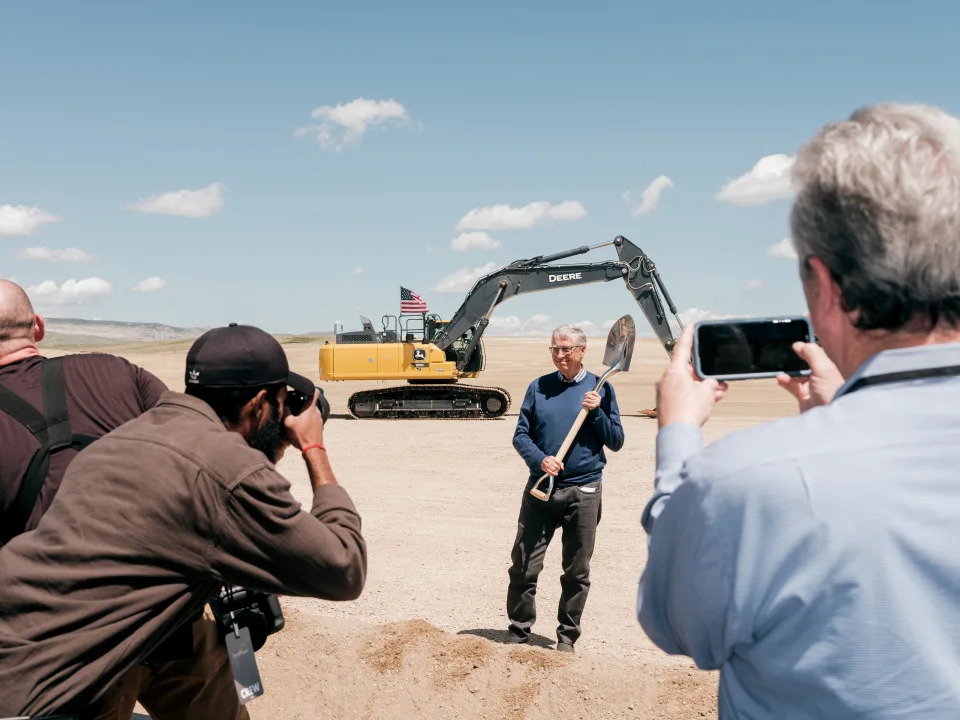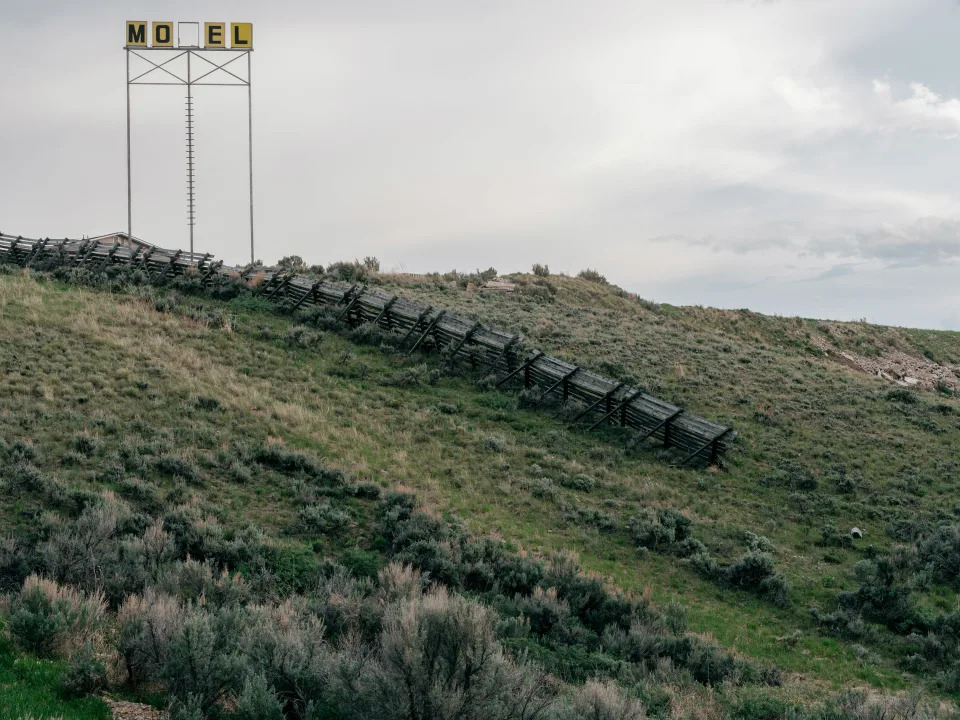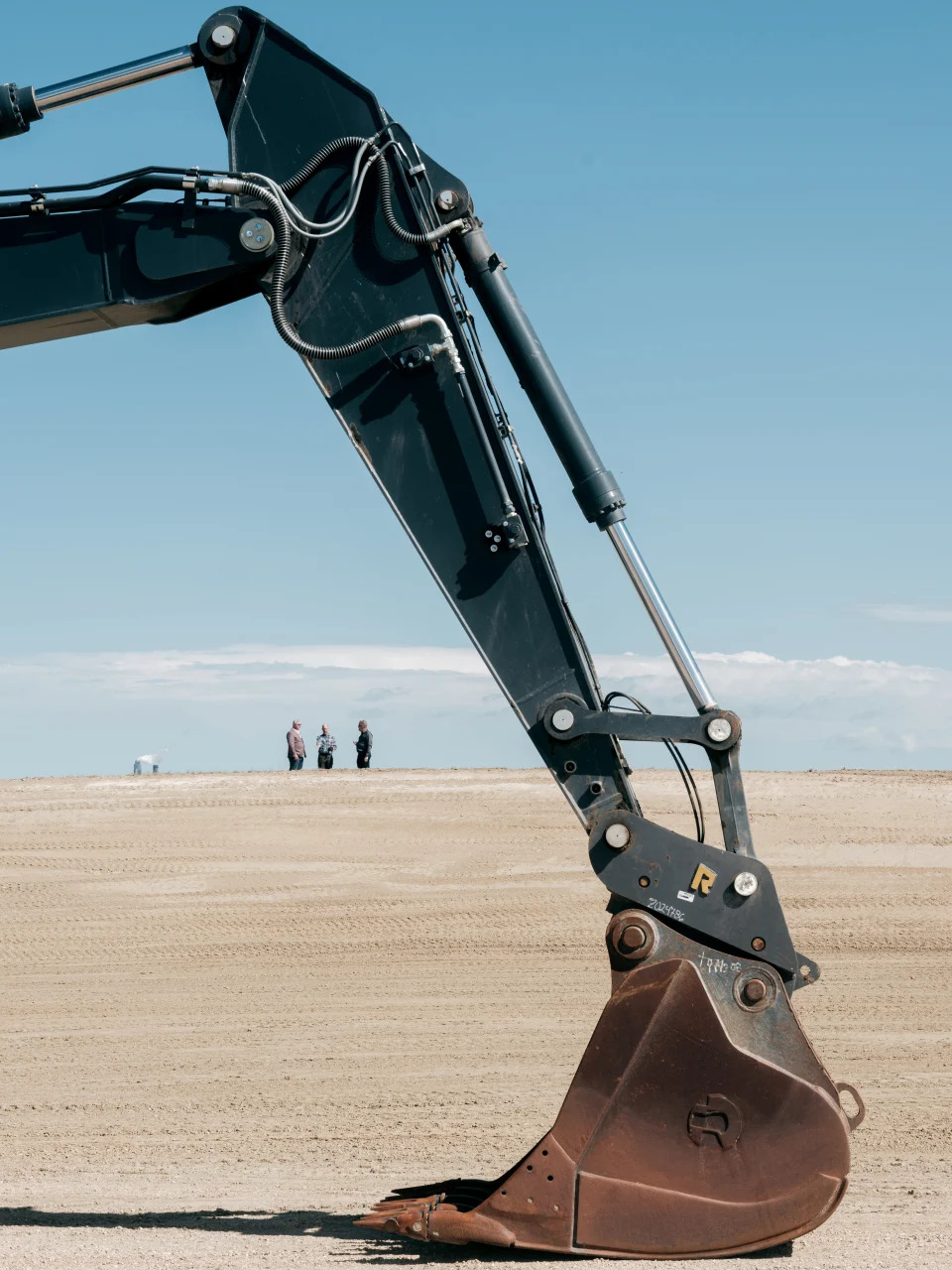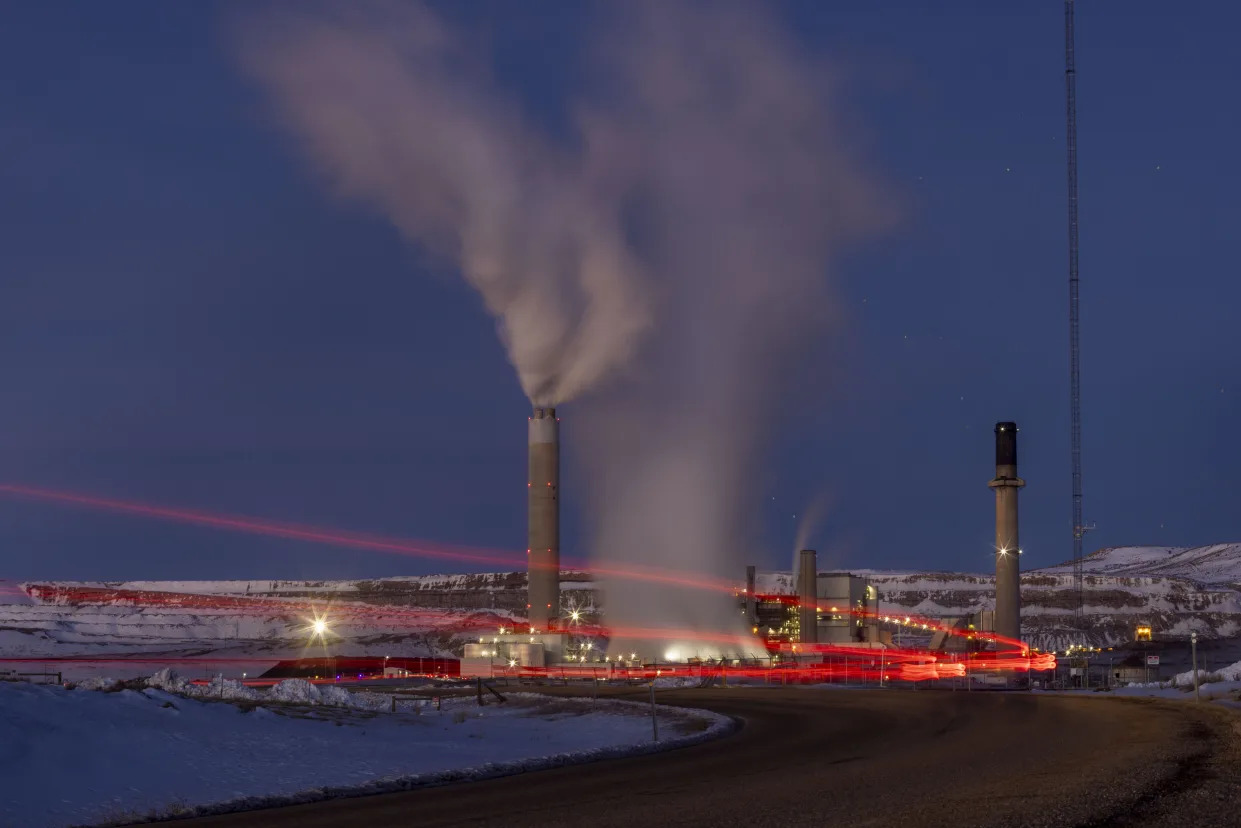Brad Plumer
The New York Times
Tue, June 11, 2024






Equipment at the future site of TerraPower's nuclear power plant near Kemmerer, Wyo., June 10, 2024. Bill Gates has poured $1 billion into a project in Wyoming coal country that aims to build the first in a new generation of nuclear reactors that produce emissions-free electricity. (Benjamin Rasmussen/The New York Times)
KEMMERER, Wyo. — Outside a small coal town in southwest Wyoming, a multibillion-dollar effort to build the first in a new generation of U.S. nuclear power plants is underway.
Workers began construction Tuesday on a novel type of nuclear reactor meant to be smaller and cheaper than the hulking reactors of old and designed to produce electricity without the carbon dioxide that is rapidly heating the planet.
The reactor being built by TerraPower, a startup, won’t be finished until 2030 at the earliest and faces daunting obstacles. The Nuclear Regulatory Commission hasn’t yet approved the design, and the company will have to overcome the inevitable delays and cost overruns that have doomed countless nuclear projects before.
Sign up for The Morning newsletter from the New York Times
What TerraPower does have, however, is an influential and deep-pocketed founder. Bill Gates, currently ranked as the seventh-richest person in the world, has poured more than $1 billion of his fortune into TerraPower, an amount that he expects to increase.
“If you care about climate, there are many, many locations around the world where nuclear has got to work,” Gates said during an interview near the project site Monday. “I’m not involved in TerraPower to make more money. I’m involved in TerraPower because we need to build a lot of these reactors.”
Gates, the former head of Microsoft, said he believed the best way to solve climate change was through innovations that make clean energy competitive with fossil fuels, a philosophy he described in his 2021 book, “How to Avoid a Climate Disaster.”
Nationwide, nuclear power is seeing a resurgence of interest, with several startups jockeying to build a wave of smaller reactors and the Biden administration offering hefty tax credits for new plants.
Hopes for TerraPower’s project are especially high among the 3,000 residents in the nearby Wyoming towns of Kemmerer and Diamondville. For decades, the local economy has depended on a coal-fired power plant and an adjacent mine. But that plant is scheduled to close by 2036 as the nation shifts away from burning coal.
A new reactor, and the jobs that come with it, could offer a lifeline.
“When the talk a few years ago was that we were losing the coal mine and the power plant, this wasn’t a happy community,” said Mary Crosby, a Kemmerer resident and the county grant writer. The reactor, she said, “gives us a chance.”
At a recent conference in New York, David Crane, the Energy Department undersecretary for infrastructure, said that two years ago he “didn’t really see” a case for next-generation reactors. But as demand for electricity surges because of new data centers, factories and electric vehicles, Crane said he had become “very bullish” on nuclear to provide carbon-free power around the clock without needing much land.
The challenge was building the plants, Crane said. “Nothing we’re trying to do is easy.”
A New Type of Reactor
Gates became interested in nuclear power in the early 2000s after scientists persuaded him of the need for vast amounts of emissions-free electricity to fight global warming. He was skeptical that wind and solar power, which don’t run at all hours, would be enough.
“Wind and solar are absolutely fantastic, and we have to build them as fast as we can, but the idea that we don’t need anything beyond that is very unlikely,” Gates said. How, he asked, would Chicago heat homes during long winter stretches with little wind or sun?
One problem with nuclear power, though, is that it has become prohibitively expensive. Traditional reactors are huge, complex, strictly regulated projects that are difficult to build and finance. The only two U.S. reactors built in the past 30 years, Vogtle Units 3 and 4 in Georgia, cost $35 billion, more than double initial estimates, and arrived seven years behind schedule.
Gates is betting that radically different technology will help. With TerraPower, he funded a team of hundreds of engineers to redesign a nuclear plant from scratch.
Today, every U.S. nuclear plant uses light-water reactors, in which water is pumped into a reactor core and heated by atomic fission, producing steam to create electricity. Because the water is highly pressurized, these plants need heavy piping and thick containment shields to protect against accidents.
TerraPower’s reactor, by contrast, uses liquid sodium instead of water, allowing it to operate at lower pressures. In theory, that reduces the need for thick shielding. In an emergency, the plant can be cooled with air vents rather than complicated pump systems. The reactor is just 345 megawatts, one-third the size of Vogtle’s reactors, making for a smaller investment.
Chris Levesque, TerraPower’s CEO, said its reactors should ultimately produce electricity at half the cost of traditional nuclear plants. “This is a much simpler plant,” he said. “That gives us both a safety benefit and a cost benefit.”
TerraPower’s design has another unique feature. Most reactors can’t easily adjust their power output, making it hard to mesh with fluctuating wind and solar farms. TerraPower’s reactor will have a molten salt battery that allows the plant to ramp up or down as needed.
“That helps with the economics,” Levesque said. “We can store energy and then sell it to the grid when it has a higher value.”
Still, it remains to be seen whether TerraPower can achieve lower costs. In 2022, the company estimated that its Kemmerer reactor would cost $4 billion, with the Energy Department contributing up to $2 billion. That’s already pricier than modern gas or renewable plants, and costs could rise further.
Most recent attempts to build nuclear plants have been hobbled by delays and unforeseen expenses, said David Schlissel, a director at the Institute for Energy Economics and Financial Analysis. Last year in Idaho, NuScale, another startup, abandoned plans to build six small light-water reactors after struggling with price increases.
“There’s no evidence these small reactors are going to be built any faster or any cheaper than larger ones,” Schlissel said, arguing that utilities should prioritize safer investments such as wind, solar and batteries.
Gates conceded that TerraPower’s first plant was likely to be especially expensive as the company navigated a learning curve. But, he said, he could absorb that financial risk in a way that utilities and regulators can’t. (In addition to Gates, TerraPower has raised $830 million from outside investors.)
The company says that if it can push past initial hurdles and build multiple reactors, it can drive costs down to be economically competitive.
“We’re taking that risk, which, because of our design, we feel very good about,” Gates said. “But it means you need very deep pockets.”
Looking for a Lifeline
In Kemmerer, officials are hoping that bet pays off. This part of Wyoming has relied on coal, oil and gas since the first mine opened in 1887, but America’s coal consumption has fallen by half over the past two decades.
The Naughton coal plant, south of town, dominates the sagebrush landscape and, at its peak, employed nearly 250 workers. When the utility that owns it, PacifiCorp, announced a few years ago that it would retire the facility, many wondered what could possibly replace it. The closure has since been delayed to 2036.
In 2021, TerraPower decided that a nearby site was ideal for a new reactor, since the company could reuse the coal plant’s transmission lines and retrain its workers. The nuclear plant would employ 250 people and create 1,600 temporary construction jobs.
“Now I’ve got people all over the country calling and saying, I want to be on that job,” said Jerry Payne, business manager of the International Brotherhood of Electric Workers Local 322, the union that represents many coal plant workers. “It means a lot for Kemmerer.”
After losing residents for decades, Kemmerer is showing signs of revival. A new coffee shop, Fossil Fuel Coffee Co., and several businesses have opened downtown and two sprawling housing developments are planned on the outskirts.
Concerns about the project linger, especially over its timeline. In 2022, TerraPower announced a two-year delay because it would no longer buy nuclear fuel from Russia and needed to find a new supplier.
“People kept asking, is this thing ever going to be built?” said Bill Thek, the Kemmerer mayor. “But now that we’re seeing dirt moving, that’s energizing.”
Last fall, the Nuclear Regulatory Commission held a hearing in town to field questions from some nervous residents. Do regulators account for earthquakes? (Yes.) Is there a permanent place to store the plant’s radioactive waste? (Not yet.)
“There are people who are excited, and also people who are uncomfortable with the technology,” said Madonna Long, who was born in Kemmerer, left for a few decades, and returned in 2020 to open a medical supply business. “But we don’t have anybody knocking on our door and saying, ‘Hey, I’ll build something else.’”
The Energy Department estimates that hundreds of retiring or closed coal plants nationwide could be suitable locations for new reactors, since they already have grid connections and water supplies. Doing so, the agency said, could also help coal communities avoid steep economic losses.
Challenges Ahead
In March, TerraPower submitted a 3,300-page application to the Nuclear Regulatory Commission for a permit to build the reactor, but that will take at least two years to review. The company has to persuade regulators that its sodium-cooled reactor doesn’t need many of the costly safeguards required for traditional light-water reactors.
“That’s going to be challenging,” said Adam Stein, director of nuclear innovation at the Breakthrough Institute, a pro-nuclear research organization.
TerraPower’s plant is designed so that major components, like the steam turbines that generate electricity and the molten salt battery, are physically separate from the reactor, where fission occurs. The company says those parts don’t require regulatory approval and can begin construction sooner.
A bigger obstacle might be procuring fuel, since today Russia is the only supplier of the specialized enriched uranium used by TerraPower. While Congress has allocated $3.4 billion to bolster domestic fuel supplies, that will take time.
The company does have a customer: PacifiCorp, which provides power across six Western states, plans to purchase electricity from TerraPower’s first reactor and has expressed interest in additional reactors after that. The utility says any cost overruns will be borne by TerraPower, not ratepayers. But that agreement hasn’t been finalized, and some critics worry about the effect on household electricity bills.
“It’s fine for people to be skeptical about this, because nuclear has failed again and again,” Gates said. “A lot of things could go wrong or delay us. But it’s such an important project that I’m basically standing by it financially. I do see it as utterly different from every other fission project being done.”
c.2024 The New York Times Company
In Wyoming, Bill Gates moves ahead with nuclear project aimed at revolutionizing power generation
Tue, June 11, 2024
Equipment at the future site of TerraPower's nuclear power plant near Kemmerer, Wyo., June 10, 2024. Bill Gates has poured $1 billion into a project in Wyoming coal country that aims to build the first in a new generation of nuclear reactors that produce emissions-free electricity. (Benjamin Rasmussen/The New York Times)
KEMMERER, Wyo. — Outside a small coal town in southwest Wyoming, a multibillion-dollar effort to build the first in a new generation of U.S. nuclear power plants is underway.
Workers began construction Tuesday on a novel type of nuclear reactor meant to be smaller and cheaper than the hulking reactors of old and designed to produce electricity without the carbon dioxide that is rapidly heating the planet.
The reactor being built by TerraPower, a startup, won’t be finished until 2030 at the earliest and faces daunting obstacles. The Nuclear Regulatory Commission hasn’t yet approved the design, and the company will have to overcome the inevitable delays and cost overruns that have doomed countless nuclear projects before.
Sign up for The Morning newsletter from the New York Times
What TerraPower does have, however, is an influential and deep-pocketed founder. Bill Gates, currently ranked as the seventh-richest person in the world, has poured more than $1 billion of his fortune into TerraPower, an amount that he expects to increase.
“If you care about climate, there are many, many locations around the world where nuclear has got to work,” Gates said during an interview near the project site Monday. “I’m not involved in TerraPower to make more money. I’m involved in TerraPower because we need to build a lot of these reactors.”
Gates, the former head of Microsoft, said he believed the best way to solve climate change was through innovations that make clean energy competitive with fossil fuels, a philosophy he described in his 2021 book, “How to Avoid a Climate Disaster.”
Nationwide, nuclear power is seeing a resurgence of interest, with several startups jockeying to build a wave of smaller reactors and the Biden administration offering hefty tax credits for new plants.
Hopes for TerraPower’s project are especially high among the 3,000 residents in the nearby Wyoming towns of Kemmerer and Diamondville. For decades, the local economy has depended on a coal-fired power plant and an adjacent mine. But that plant is scheduled to close by 2036 as the nation shifts away from burning coal.
A new reactor, and the jobs that come with it, could offer a lifeline.
“When the talk a few years ago was that we were losing the coal mine and the power plant, this wasn’t a happy community,” said Mary Crosby, a Kemmerer resident and the county grant writer. The reactor, she said, “gives us a chance.”
At a recent conference in New York, David Crane, the Energy Department undersecretary for infrastructure, said that two years ago he “didn’t really see” a case for next-generation reactors. But as demand for electricity surges because of new data centers, factories and electric vehicles, Crane said he had become “very bullish” on nuclear to provide carbon-free power around the clock without needing much land.
The challenge was building the plants, Crane said. “Nothing we’re trying to do is easy.”
A New Type of Reactor
Gates became interested in nuclear power in the early 2000s after scientists persuaded him of the need for vast amounts of emissions-free electricity to fight global warming. He was skeptical that wind and solar power, which don’t run at all hours, would be enough.
“Wind and solar are absolutely fantastic, and we have to build them as fast as we can, but the idea that we don’t need anything beyond that is very unlikely,” Gates said. How, he asked, would Chicago heat homes during long winter stretches with little wind or sun?
One problem with nuclear power, though, is that it has become prohibitively expensive. Traditional reactors are huge, complex, strictly regulated projects that are difficult to build and finance. The only two U.S. reactors built in the past 30 years, Vogtle Units 3 and 4 in Georgia, cost $35 billion, more than double initial estimates, and arrived seven years behind schedule.
Gates is betting that radically different technology will help. With TerraPower, he funded a team of hundreds of engineers to redesign a nuclear plant from scratch.
Today, every U.S. nuclear plant uses light-water reactors, in which water is pumped into a reactor core and heated by atomic fission, producing steam to create electricity. Because the water is highly pressurized, these plants need heavy piping and thick containment shields to protect against accidents.
TerraPower’s reactor, by contrast, uses liquid sodium instead of water, allowing it to operate at lower pressures. In theory, that reduces the need for thick shielding. In an emergency, the plant can be cooled with air vents rather than complicated pump systems. The reactor is just 345 megawatts, one-third the size of Vogtle’s reactors, making for a smaller investment.
Chris Levesque, TerraPower’s CEO, said its reactors should ultimately produce electricity at half the cost of traditional nuclear plants. “This is a much simpler plant,” he said. “That gives us both a safety benefit and a cost benefit.”
TerraPower’s design has another unique feature. Most reactors can’t easily adjust their power output, making it hard to mesh with fluctuating wind and solar farms. TerraPower’s reactor will have a molten salt battery that allows the plant to ramp up or down as needed.
“That helps with the economics,” Levesque said. “We can store energy and then sell it to the grid when it has a higher value.”
Still, it remains to be seen whether TerraPower can achieve lower costs. In 2022, the company estimated that its Kemmerer reactor would cost $4 billion, with the Energy Department contributing up to $2 billion. That’s already pricier than modern gas or renewable plants, and costs could rise further.
Most recent attempts to build nuclear plants have been hobbled by delays and unforeseen expenses, said David Schlissel, a director at the Institute for Energy Economics and Financial Analysis. Last year in Idaho, NuScale, another startup, abandoned plans to build six small light-water reactors after struggling with price increases.
“There’s no evidence these small reactors are going to be built any faster or any cheaper than larger ones,” Schlissel said, arguing that utilities should prioritize safer investments such as wind, solar and batteries.
Gates conceded that TerraPower’s first plant was likely to be especially expensive as the company navigated a learning curve. But, he said, he could absorb that financial risk in a way that utilities and regulators can’t. (In addition to Gates, TerraPower has raised $830 million from outside investors.)
The company says that if it can push past initial hurdles and build multiple reactors, it can drive costs down to be economically competitive.
“We’re taking that risk, which, because of our design, we feel very good about,” Gates said. “But it means you need very deep pockets.”
Looking for a Lifeline
In Kemmerer, officials are hoping that bet pays off. This part of Wyoming has relied on coal, oil and gas since the first mine opened in 1887, but America’s coal consumption has fallen by half over the past two decades.
The Naughton coal plant, south of town, dominates the sagebrush landscape and, at its peak, employed nearly 250 workers. When the utility that owns it, PacifiCorp, announced a few years ago that it would retire the facility, many wondered what could possibly replace it. The closure has since been delayed to 2036.
In 2021, TerraPower decided that a nearby site was ideal for a new reactor, since the company could reuse the coal plant’s transmission lines and retrain its workers. The nuclear plant would employ 250 people and create 1,600 temporary construction jobs.
“Now I’ve got people all over the country calling and saying, I want to be on that job,” said Jerry Payne, business manager of the International Brotherhood of Electric Workers Local 322, the union that represents many coal plant workers. “It means a lot for Kemmerer.”
After losing residents for decades, Kemmerer is showing signs of revival. A new coffee shop, Fossil Fuel Coffee Co., and several businesses have opened downtown and two sprawling housing developments are planned on the outskirts.
Concerns about the project linger, especially over its timeline. In 2022, TerraPower announced a two-year delay because it would no longer buy nuclear fuel from Russia and needed to find a new supplier.
“People kept asking, is this thing ever going to be built?” said Bill Thek, the Kemmerer mayor. “But now that we’re seeing dirt moving, that’s energizing.”
Last fall, the Nuclear Regulatory Commission held a hearing in town to field questions from some nervous residents. Do regulators account for earthquakes? (Yes.) Is there a permanent place to store the plant’s radioactive waste? (Not yet.)
“There are people who are excited, and also people who are uncomfortable with the technology,” said Madonna Long, who was born in Kemmerer, left for a few decades, and returned in 2020 to open a medical supply business. “But we don’t have anybody knocking on our door and saying, ‘Hey, I’ll build something else.’”
The Energy Department estimates that hundreds of retiring or closed coal plants nationwide could be suitable locations for new reactors, since they already have grid connections and water supplies. Doing so, the agency said, could also help coal communities avoid steep economic losses.
Challenges Ahead
In March, TerraPower submitted a 3,300-page application to the Nuclear Regulatory Commission for a permit to build the reactor, but that will take at least two years to review. The company has to persuade regulators that its sodium-cooled reactor doesn’t need many of the costly safeguards required for traditional light-water reactors.
“That’s going to be challenging,” said Adam Stein, director of nuclear innovation at the Breakthrough Institute, a pro-nuclear research organization.
TerraPower’s plant is designed so that major components, like the steam turbines that generate electricity and the molten salt battery, are physically separate from the reactor, where fission occurs. The company says those parts don’t require regulatory approval and can begin construction sooner.
A bigger obstacle might be procuring fuel, since today Russia is the only supplier of the specialized enriched uranium used by TerraPower. While Congress has allocated $3.4 billion to bolster domestic fuel supplies, that will take time.
The company does have a customer: PacifiCorp, which provides power across six Western states, plans to purchase electricity from TerraPower’s first reactor and has expressed interest in additional reactors after that. The utility says any cost overruns will be borne by TerraPower, not ratepayers. But that agreement hasn’t been finalized, and some critics worry about the effect on household electricity bills.
“It’s fine for people to be skeptical about this, because nuclear has failed again and again,” Gates said. “A lot of things could go wrong or delay us. But it’s such an important project that I’m basically standing by it financially. I do see it as utterly different from every other fission project being done.”
c.2024 The New York Times Company
In Wyoming, Bill Gates moves ahead with nuclear project aimed at revolutionizing power generation
JENNIFER McDERMOTT
Mon, June 10, 2024

Taillights trace the path of a motor vehicle at the Naughton Power Plant, Jan. 13, 2022, in Kemmerer, Wyo. Bill Gates and his energy company are starting construction at their Wyoming site adjacent to the coal plant for a next-generation nuclear power plant he believes will “revolutionize” how power is generated. (AP Photo/Natalie Behring, File)
Bill Gates and his energy company are starting construction at their Wyoming site for a next-generation nuclear power plant he believes will “revolutionize” how power is generated.
Gates was in the tiny community of Kemmerer Monday to break ground on the project. The co-founder of Microsoft is chairman of TerraPower. The company applied to the Nuclear Regulatory Commission in March for a construction permit for an advanced nuclear reactor that uses sodium, not water, for cooling. If approved, it would operate as a commercial nuclear power plant.
The site is adjacent to PacifiCorp’s Naughton Power Plant, which will stop burning coal in 2026 and natural gas a decade later, the utility said. Nuclear reactors operate without emitting planet-warming greenhouse gases. PacifiCorp plans to get carbon-free power from the reactor and says it is weighing how much nuclear to include in its long-range planning.
The work begun Monday is aimed at having the site ready so TerraPower can build the reactor as quickly as possible if its permit is approved. Russia is at the forefront for developing sodium-cooled reactors.
Gates told the audience at the groundbreaking that they were “standing on what will soon be the bedrock of America’s energy future.”
“This is a big step toward safe, abundant, zero-carbon energy,” Gates said. “And it’s important for the future of this country that projects like this succeed.”
Advanced reactors typically use a coolant other than water and operate at lower pressures and higher temperatures. Such technology has been around for decades, but the United States has continued to build large, conventional water-cooled reactors as commercial power plants. The Wyoming project is the first time in about four decades that a company has tried to get an advanced reactor up and running as a commercial power plant in the United States, according to the NRC.
It’s time to move to advanced nuclear technology that uses the latest computer modeling and physics for a simpler plant design that’s cheaper, even safer and more efficient, said Chris Levesque, the company’s president and chief executive officer.
TerraPower's Natrium reactor demonstration project is a sodium-cooled fast reactor design with a molten salt energy storage system.
“The industry’s character hasn’t been to innovate. It’s kind of been to repeat past performance, you know, not to move forward with new technology. And that was good for reliability,” Levesque said in an interview. “But the electricity demands we’re seeing in the coming decades, and also to correct the cost issues with today’s nuclear and nuclear energy, we at TerraPower and our founders really felt it’s time to innovate.”
A Georgia utility just finished the first two scratch-built American reactors in a generation at a cost of nearly $35 billion. The price tag for the expansion of Plant Vogtle from two of the traditional large reactors to four includes $11 billion in cost overruns.
The TerraPower project is expected to cost up to $4 billion, half of it from the U.S. Department of Energy. Levesque said that figure includes first-of-its-kind costs for designing and licensing the reactor, so future ones would cost significantly less.
Most advanced nuclear reactors under development in the U.S. rely on a type of fuel — known as high-assay low-enriched uranium — that's enriched to a higher percentage of the isotope uranium-235 than the fuel used by conventional reactors. TerraPower delayed its launch date in Wyoming by two years to 2030 because Russia is the only commercial supplier of the fuel, and it’s working with other companies to develop alternate supplies. The U.S. Energy Department is working on developing it domestically.
Edwin Lyman co-authored an article in Science on Thursday that raises concerns that this fuel could be used for nuclear weapons. Lyman, the director of nuclear power safety with the Union of Concerned Scientists, said the risk posed by HALEU today is small because there isn’t that much of it around the world. But that will change if advanced reactor projects, which require much larger quantities, move forward, he added. Lyman said he wants to raise awareness of the danger in the hope that the international community will strengthen security around the fuel.
NRC spokesperson Scott Burnell said the agency is confident its current requirements will maintain both security and public safety of any reactors that are built and their fuel.
Gates co-founded TerraPower in 2008 as a way for the private sector to propel advanced nuclear energy forward to provide safe, abundant, carbon-free energy.
The company's 345-megawatt reactor could generate up to 500 megawatts at its peak, enough for up to 400,000 homes. TerraPower said its first few reactors will focus on supplying electricity. But it envisions future reactors could be built near industrial plants to supply high heat.
Nearly all industrial processes requiring high heat currently get it from burning fossil fuels. Heat from advanced reactors could be used to produce hydrogen, petrochemicals, ammonia and fertilizer, said John Kotek at the Nuclear Energy Institute.
It’s significant that Gates, a technological innovator and climate champion, is betting on nuclear power to help address the climate crisis, added Kotek, the industry group’s senior vice president for policy.
“I think this has helped open people’s eyes to the role that nuclear power does play today and can play in the future in addressing carbon emissions," he said. “There’s tremendous momentum building for new nuclear in the U.S. and the potential use of a far wider range of nuclear energy technology than we’ve seen in decades.”
___
The Associated Press’ climate and environmental coverage receives financial support from multiple private foundations. AP is solely responsible for all content. Find AP’s standards for working with philanthropies, a list of supporters and funded coverage areas at AP.org.
No comments:
Post a Comment